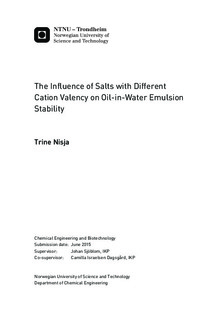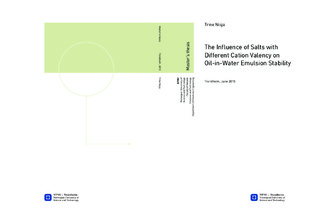| dc.contributor.advisor | Sjöblom, Johan | |
| dc.contributor.advisor | Dagsgård, Camilla Israelsen | |
| dc.contributor.author | Nisja, Trine | |
| dc.date.accessioned | 2015-10-06T07:36:52Z | |
| dc.date.available | 2015-10-06T07:36:52Z | |
| dc.date.created | 2015-06-26 | |
| dc.date.issued | 2015 | |
| dc.identifier | ntnudaim:13190 | |
| dc.identifier.uri | http://hdl.handle.net/11250/2351674 | |
| dc.description.abstract | The effect of different emulsion preparation parameters on the stability of oil-in-water (o/w)
emulsions has been studied by varying the preparation parameters and then observing the emulsion
visually. Change in the turbidity of an emulsion indicated instability, and the formation of a
dense layer on the top of the emulsion suggested that creaming had commenced. The creaming
rate was diminishing with increasing mixing frequency, mixing time and oil phase density. The
study was limited by foam build-up, as the unwanted foam made it necessary to keep mixing
frequency and surfactant amount to a minimum.
The influence of diluted salts of different valencies on the stability of o/w emulsions has been
investigated bymeasuring the zeta potential of emulsionswith varying electrolyte concentration
and electrolyte cation valency. The destabilising effect of adding divalent Ca2+ was stronger than
that ofNa+, whichwas observed by the difference in electrolyte concentration required to reduce
the absolute value of zeta potential. This strongly implies that the higher valency of Ca2+ more
readily contributes to a compression of the electrical double layer than does Na+. Contrary to
expectations, the addition of trivalent Al3+ and Fe3+ was not observed to affect the stability. It
was concluded that this deviation from theory was due to experimental limitations.
A new method for droplet size characterisation and oil profile for w/o emulsions with low-field
nuclear magnetic resonance (NMR) has been developed and tested for o/w emulsions in collaboration
with the NMR supplier, Antek AS. Implementation of a convection compensating
sequence by Antek AS was successful. The new procedure makes it possible to retrieve quantitative
data on the droplet size and oil profile of an o/w emulsion over time, which can provide
good insight into emulsion stability. | |
| dc.language | eng | |
| dc.publisher | NTNU | |
| dc.subject | Industriell kjemi og bioteknologi, Kolloid- og polymerkjemi | |
| dc.title | The Influence of Salts with Different Cation Valency on Oil-in-Water Emulsion Stability | |
| dc.type | Master thesis | |
| dc.source.pagenumber | 75 | |

